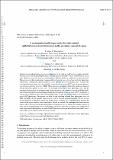A mathematical multi-organ model for bidirectional epithelial-mesenchymal transitions in the metastatic spread of cancer
Abstract
Cancer invasion and metastatic spread to secondary sites in the body are facilitated by a complex interplay between cancer cells of different phenotypes and their microenvironment. A trade-off between the cancer cells’ ability to invade the tissue and to metastasize, and their ability to proliferate has been observed. This gives rise to the classification of cancer cells into those of mesenchymal and epithelial phenotype, respectively. Additionally, mixed phenotypic states between these two extremes exist. Cancer cells can transit between these states via epithelial–mesenchymal transition (EMT) and the reverse process, mesenchymal–epithelial transition (MET). These processes are crucial for both the local tissue invasion and the metastatic spread of cancer cells. To shed light on the role of these phenotypic states and the transitions between them in the invasive and metastatic process, we extend our recently published multi-grid, hybrid, individual-based mathematical metastasis framework (Franssen et al. 2019, A mathematical framework for modelling the metastatic spread of cancer. Bull. Math. Biol., 81, 1965). In addition to cancer cells of epithelial and of mesenchymal phenotype, we now also include those of an intermediate partial-EMT phenotype. Furthermore, we allow for the switching between these phenotypic states via EMT and MET at the biologically appropriate steps of the invasion-metastasis cascade. We also account for the likelihood of spread of cancer cells to the various secondary sites and differentiate between the tissues of the organs involved in our simulations. Finally, we consider the maladaptation of metastasized cancer cells to the new tumour microenvironment at secondary sites as well as the immune response at these sites by accounting for cancer cell dormancy and death. This way, we create a first mathematical multi-organ model that explicitly accounts for EMT-processes occurring at the level of individual cancer cells in the context of the invasion-metastasis cascade.
Citation
Franßen , L C & Chaplain , M A J 2020 , ' A mathematical multi-organ model for bidirectional epithelial-mesenchymal transitions in the metastatic spread of cancer ' , IMA Journal of Applied Mathematics , vol. 85 , no. 5 , pp. 724-761 . https://doi.org/10.1093/imamat/hxaa022
Publication
IMA Journal of Applied Mathematics
Status
Peer reviewed
ISSN
0272-4960Type
Journal article
Description
Funding: Engineering and Physical Sciences Research Council (EPSRC) [to L.C.F.]; EPSRC Grant No. EP/N014642/1 (EPSRC Centre for Multiscale Soft Tissue Mechanics WithApplication to Heart & Cancer) [to M.A.J.C.].Collections
Items in the St Andrews Research Repository are protected by copyright, with all rights reserved, unless otherwise indicated.

